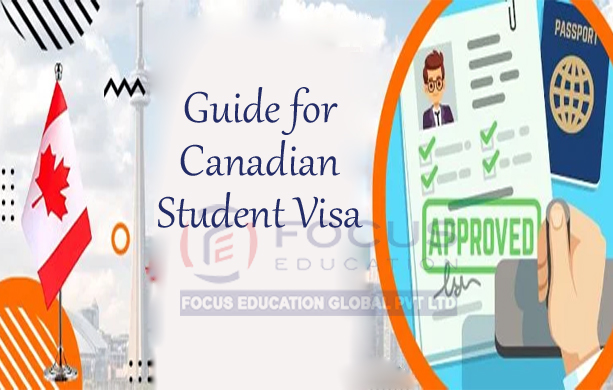Guide for Canadian Student Visa
For many international students, starting an educational journey in Canada is a highly desired goal. However, getting a student visa to Canada is a difficult process that frequently involves unanticipated difficulties. This extensive guide will cover the specific steps needed to obtain a student visa for Canada, by explaining the differences between a Regular Study Permit and the Student Direct Stream, outline the qualities of a strong applicant, and clarifying the top 10 reasons that could result in the denial of an application for a student visa to Canada.
The Journey to a Canada Visa: Obtaining a Canada student visa is a meticulous, multi-step process that necessitates careful planning and observance of specific guidelines. The key steps include:
1. Acceptance into a Designated Learning Institute (DLI):
Prospective students must first be admitted to a DLI before submitting an application for a student visa to study in Canada.
2. Gather Necessary Documents:
Candidates must gather a complete set of supporting documentation, which may include a DLI acceptance letter, evidence of financial stability, language competency exam results, and other records.
3. Create a GC Key Account:
As part of the online application process, applicants are required to create a GC Key account to access the Canadian government’s online services.
4. Submit the Online Application:
Using the Immigration, Refugees, and Citizenship Canada (IRCC) website, applicants must submit their online visa application, paying careful attention to accuracy and completeness.
5. Biometrics and Medical Examination:
Applicants may undergo biometric data collection and a medical examination as part of the visa application process.
6. Wait for Processing:
After submission, applications undergo a thorough review process, and applicants must patiently await a decision.
Student Direct Stream vs. Regular Study Permit: Prospective international students must comprehend the differences between the Regular Study Permit and the Student Direct Stream (SDS).
1. Student Direct Stream (SDS):
SDS is an expedited processing system available to students from select countries, streamlining the visa application process with faster turnaround times. Applicants must fulfil certain requirements, such as financial requirements and language competency, in order to be eligible for SDS.
2. Regular Study Permit:
The Regular Study Permit is the standard application process, which may take longer than SDS but remains a viable option for students who do not meet the criteria for the expedited stream.
Profile of a Successful Candidate: A successful candidate for a Canada student visa often possesses the following attributes:
1. Admission to a Designated Learning Institution (DLI):
Successful candidates have to secure admission to a recognized DLI, demonstrating their commitment to pursuing quality education.
2. Sufficient Financial Resources:
Demonstrating the ability to cover tuition fees, living expenses, and other related costs is vital. This involves presenting clear and comprehensive financial documents, including bank statements, sponsorship letters, and other necessary details.
3. Language Proficiency:
Meeting language proficiency requirements, typically through tests like IELTS, PTE or TOEFL, is crucial for a candidate’s academic success in a Canadian institution.
4. Clear Intent and Purpose:
A compelling Statement of Purpose outlining the candidate’s educational and career goals, along with their intent to return to their home country after studies, strengthens their application.
5. Observance of Visa Regulations:
Candidates have a better chance of being approved if they carefully follow the instructions for applying for a visa and provide accurate information.
Top 10 Reasons for Rejection of Canada Student Visa Applications:
1. Insufficient Financial Proof:
The inability to demonstrate sufficient financial capacity is a common reason for rejection. Comprehensive and accurate financial documents are crucial.
2. Lack of Genuine Intent:
Visa officers examine statements of purpose and interviews to assess the sincerity of intentions. A clear educational and career plan is essential.
3. Inadequate Documentation:
The error of required documents can lead to delays or rejection. Applicants should carefully review and accurately complete the document checklist.
4. Low Language Proficiency:
Meeting language proficiency requirements is paramount. Adequate preparation for language proficiency tests is crucial for success.
5. Criminal Record:
Applicants with a criminal record may face challenges. Providing comprehensive information and evidence of rehabilitation is essential.
6. Medical Inadmissibility:
Failing to meet health standards or posing a risk to public health may result in rejection. Professional guidance and comprehensive medical documentation are advised.
7. Unstable Political Situation:
Applicants from politically unstable regions may face increased scrutiny. Providing context and emphasizing a commitment to Canadian laws is crucial.
8. Misrepresentation:
Providing false information is a serious offense. Transparency and honesty throughout the application process are essential.
9. Academic Ineligibility:
Failing to meet academic requirements is a common reason for rejection. Applicants should carefully review and meet or exceed the academic prerequisites.
10. Overstay History:
Individuals with a history of overstaying visas may be deemed high-risk. Providing a detailed explanation, evidence of compliance, and a plan for adherence to Canadian visa regulations is essential.
Conclusion:
Navigating the process of securing a student visa for Canada requires careful planning and deep comprehension of the nuts and bolts. By familiarizing themselves with the essentials of the application process, prospective students can address potential pitfalls and enhance their chances of securing a Canada student visa. To ensure a successful academic journey in Canada, candidates must carefully evaluate the profile of a successful candidate and precisely address the top 10 causes for rejection, regardless of which option they choose—the Regular Study Permit or the Student Direct Stream.
Embarking on your academic journey in Canada is a strategic move towards a future-ready career. As you contemplate this academic endeavor, consider the multifaceted advantages that Canada presents, ensuring a well-rounded and rewarding path into the dynamic realm of your academic journey. Feel free to get in touch with Focus Education team for any further queries.



